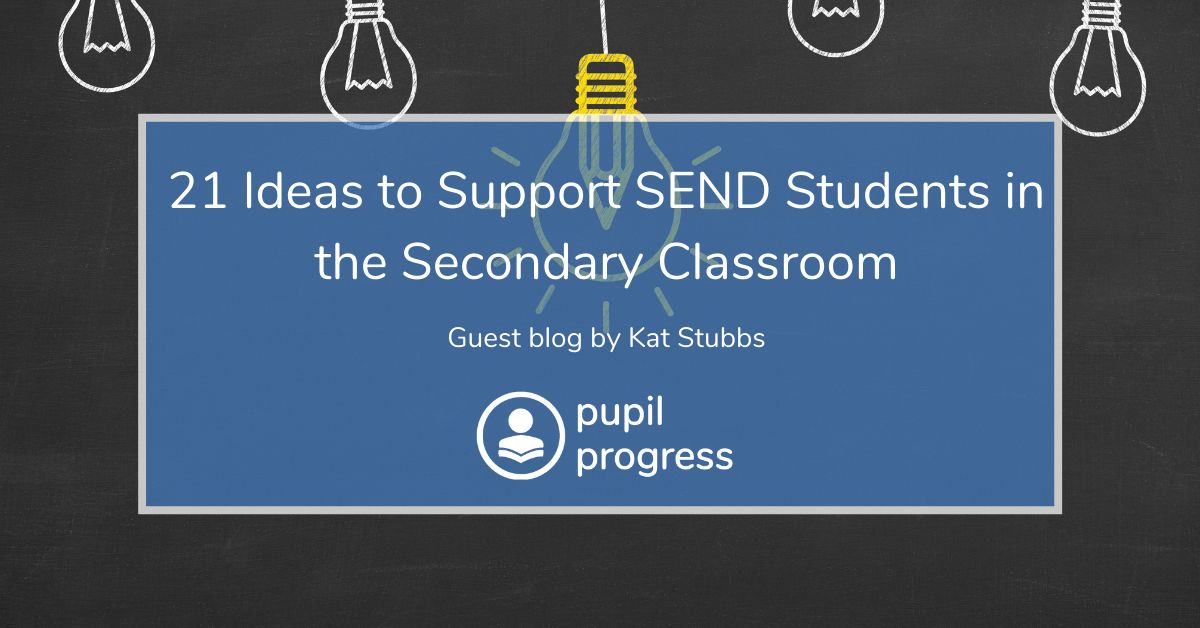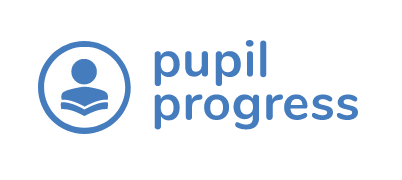21 Ideas to Support SEND Students in the Secondary Classroom

Do you ever feel caught between that metaphorical rock and the hard place? Constricted by time, yet driven by the love for what you do and the yearning to get it right for your students?
Here, I aim to give you some tried and tested quick and easy ideas to make learning more accessible for your SEND students in the secondary classroom – so you can get it right, without spending hours cutting out in front of the TV/making worksheets/scouring Twitter/crying internally…*delete as appropriate*.
Let’s get straight to it:
1. Task Plans. I’ve seen these laid out in a number of ways, depending on student needs and interests – the best ones including a speedo, a train journey, and a timer. They basically outline the task you want the students to complete and in which order. A visual prompt, if you will. Keep a helpful laminated stack at the back of the room
2. Planning on mini-whiteboards. I’m lucky that in my current school, all of our students carry a whiteboard as part of their equipment – but in my previous SEND Co-post, I made sure that all of our SEND (special educational needs and disability) learners did. These can be used for students to jot down ideas independently when you’re talking, for them to plan on, for you to joint plan on, provide sentence starters on – as a task plan (see above!)…they basically are brilliant for anyone with any kind of memory issue as the whiteboard means they can be independent and are not constantly relying on their short-term memory
3. Using visual representations. Most written subjects in secondary schools nowadays use a mnemonic as a way to prompt students to remember what they need to include in extended writing. Instead of using words (as SEND students can often struggle to recall these) could you use an image instead? This works particularly well for students with MLD or those with dyslexia. Use an image prompt instead of a word or letter for each part of the writing – try to use something simple that they can sketch quickly on the side of the exam paper
4. Flashcards. In the current climate of exam-focused assessment, it is imperative that we provide students with accessible ways to recall. I am currently trialling (as an English teacher) having students make a set of revision cards for each literature text. We have 10 key quotations (with the meaning on the back) 10 key words (from or to describe the text, with the meaning on the back) and 10 context facts (date on one side, event on the back). We revisit these at the start of each lesson in some way as part of our ‘Do Now’ – starter – activity
5. Using a ruler to read. Lots of children struggle to read out loud or struggle to follow the reading when others are reading out loud. Get students, if they do struggle, into the habit of using a ruler to follow the lines. Lots learn this in primary anyway – and this will help them keep track without ‘drawing attention’ to them doing anything different
6. Giving a choice of task to reach the same outcome. Depending on what year group you teach, and what resources you have access to, this could be really easy or take a little more planning. But, where possible, think about the outcome of the lesson – do you need to know they understand a certain topic? Can analyse? Explain? How could they demonstrate that – does it have to be written? Could you use: ipads; voice recorders; creative expression; a drawing; a mindmap (see below!)
7. Positive ‘lesson breaks’. We’ve all had little Johnny in our class. He comes in after break, and he has ants in his pants. He can’t sit still. This low-level disruption could easily become a big, ‘I’m SENDING YOU OUT’ issue. It doesn’t need to. It shouldn’t, ever, for a SEND student. Think about planning little things so that the student can move around and have a rest break to refocus. Could they give out the books? Write down everyone’s answers on the board? Whatever works for them, and you, to have a positive start
8. Non-verbal cues. Can you try using music as a prompt for timings instead of your voice? Some students get flustered with timing reminders or struggle with raised voices. Think about your presence in the room working for everyone and how you could adapt that
9. ‘Proper’ Mindmapping. This is a brilliant skill for any SEND student who is creative. Teach them how to mindmap using colours and linking images for ideas. For example, in English we might separate ideas by ‘themes’ ‘characters’ ‘key quotations’ ‘plot’ and ‘context’. The student would make the mindmap for, say, Romeo and Juliet, using a different colour for each section of the mindmap and images to represent, if they like. The colours help to embed the facts in the long-term memory for creatives
10. Key vocabulary banks. It helps for students who struggle with memory to have simple resources that allow them to be as independent as possible. As part of planning your scheme of learning, could you make a key word bank that SEND (or all) students would be provided with at the beginning of the term. You can use it for quizzing/synonym linking/antonym finding/for them to just use on the desk in front of them as a visual reminder
11. Consistent quizzing. Low-stakes quizzing has been discussed in lots of education literature and across many blogs recently, but I cannot advocate it enough for embedding information for SEND learners. These should be regular (every lesson? I use them to break up tasks) and should not cause you any work/marking/recording of marks. We – my Year 11 class and I – currently do them on our mini-whiteboards, after we’ve practised our flashcards. Students check their answers themselves and then wipe them away. We revisit key vocabulary/facts/quotations on rotation of topic, and not necessarily the topic we’re currently studying, every lesson. The aim is the information retention, not the mark
12. Usable displays. Displays are sometimes overlooked in secondary schools as a useful learning resource. During my time in an all-through school, I learnt an awful lot about useful displays from my primary colleagues. You should consider: physical access – how easy is it for them to reach and/or see the display? Language: is the language used accessible to the full range of learners? Presentation: does the typeface used, choice of colour, use of headings and so on ensure the materials are accessible to all pupils?
13. Nurture reading. Sadly, we live in an era where we still have children who are not read to at home. Consider how you can incorporate this into your classroom. Can you share your own reading for pleasure? Can you read to the students as a settling/finishing activity? How can you promote their love of reading? I’ve previously seen examples of a ‘reading corner’ in secondary classroom and also literacy intervention being delivered 1-2-1 with support staff reading with students with lower reading ages
14. Money for Talk. Each school has their own policy or ideology regarding questioning and talk in the classroom. If you don’t currently use a ‘no hands up’ rule, then a good way to ensure that all children talk or share ideas within the lesson can be using money for talk. Each student starts the lesson with a set amount of notes, and they ‘spend’ one each time the talk – and they have to spend them all by the end of the lesson. This will limit the natural dominators (once you’ve spent up, you have to shut up!) but also ensure that everyone speaks in the room. It also encourages students to consider what they say, before they say it. Top Tip: Monopoly money works well
15. Rote learning via performance. This naturally lends itself to subjects like English, History and RE. As part of students rote learning facts/quotations for exams, can you contextualise them by putting them into a re-enactment or performance? Embedding the subject knowledge in this way will improve retention but also allow a visual understanding of what they are learning
16. Sensory learning provision. Can you prep your room/space/resources for students who need a hands-on approach to learning? I usually raid charity shops over the holidays but good things to look out for, depending on your subject: plastic money; abacus; letter jigsaws; magnetic/wooden letters; objects that represent the topic your learning. These can provide opportunities to sequence/sort/process – all skills that students with SEND need to practise physically
17. Support Staff. If you are lucky enough to have an assistant in the room, a really useful tip is to get them to do anything that they do/write/provide for students in a different colour to you or to the student. It will make it instantly recognisable when you’re making where they’ve had to help and what you need to reteach/support more with
18. Find their ‘carrot’. We all work better when we care about what we’re doing. Whilst your planning, consider: what do your students want? What do your students like? What do your students need? For your SEND students, this might look a little different. Their SEND profile or passport, or their EHCP is always a good place to start at the beginning of the year. It’s your job to know it
19. Appropriate vocabulary. Can your students actually understand what you’re saying? I observed a Maths lesson not long ago, which was full of difficult subject specific vocabulary – and SEND students misbehaving. Yes, they need to know the tricky technical terms for the exam…but you need to break it down for them. Can you provide them with a simpler synonym? A visual explanation? A word bank with explanations? Whatever words for you – just be mindful of what you’re saying!
20. Overteaching. What should this be? Sticking with something until the students are confident with it and remembering it, not going on and on about it at the expense of moving on! What it should not be is you working harder than the students, or doing it for them…so how would this look? Usable displays that reinforce what you teach e.g. quotations/key spellings/characters; repeating the same information in different ways/forms; interleaving quizzes to they constantly have to go back and think – good for breaking up lessons – beginning/middle/end, not necessarily linked to what you’re currently learning; Chanting/Mnemonics/Songs
21 Remember why you’re there. I have 10 key words that stay with me, albeit classroom or office, wherever I go: resilience; patience; sacrifice; empathy; politeness; humour; self-awareness; forgiveness; hope; confidence.
Good luck!
Let me know how you get on – I tweet at @Kat_Stubbs
Kat Stubss
Kat has been teaching English for nine years across a variety of schools in Nottingham, Leeds and Bradford. Driven by her work initially as a respite foster carer, Kat is a qualified SENDCo, Designated Safeguarding Lead, and has undertaken some training to be a Specialist Teacher. Additionally, Kat holds the National Professional Qualification for Senior Leadership (NPQSL).
Kat joined Dixons Kings Academy in Bradford in 2018 as a Vice Principal. Prior to this, she worked in an all-through school, leading on SEND and English and as part of the role trained as a Specialist Leader of Education (SLE) driving improvement in both inclusion and English. Kat enables students to fulfil their potential by placing inclusive practice and good literacy at the heart of her work…and classes tea drinking and good shoes as her other two specialisms.

Comments